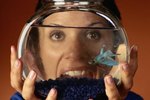Things You'll Need
2 adult male creek chub
2 to 4 adult female creek chub
Fish food flakes
Worms
Aquatic insects, such as water fleas
Brine shrimp
Powdered fish food
Creek chub are classed as larger minnows. They are often used as bait for catching larger fish, such as largemouth bass and kingfishers. They also can be kept as pets and adapt well to an aquarium environment. They are typically small fish, but in the wild they can grow up to 1 foot in length. Creek chub can be bred in an aquarium and usually live for a maximum of eight years.
Select a suitable aquarium. If you intend to breed creek chub, you will need at least a 40-gallon tank. You also will need two adult males and between two and four females, captured from their natural habitat as the spawning season begins.
Feed them three times a day. They will need to eat a varied diet of live food, such as aquatic insects and worms, and regular fish food. They will only breed if fed properly.
Remove the adults from the tank once they have spawned. Keep them in a separate aquarium, continuing to feed them a mixture of live and prepared food. The eggs should hatch in between four and six days.
Feed the larvae live brine shrimp and powdered fish food. As they grow, they will need to be weaned onto flaked fish food and small insects.
Although they favor muddy water in the wild, creek chub need to be kept in a clean environment to prevent infections and diseases. You should change the water in your aquarium regularly and keep it free from algae.
Tips
When changing the water in your aquarium, only change half the water at a time. This will allow your creek chub to acclimate to the freshwater.
References
Photo Credits
-
aquarium image by FotoWorx from Fotolia.com
Writer Bio
Luke Boston has been a freelance writer since 2009, mostly ghostwriting for nutrition websites and ebooks. His articles specialize in health and nutrition. He is a qualified nutritionist with a Bachelor of Science in nutrition. Boston also received a Master of Arts in creative media practice.





